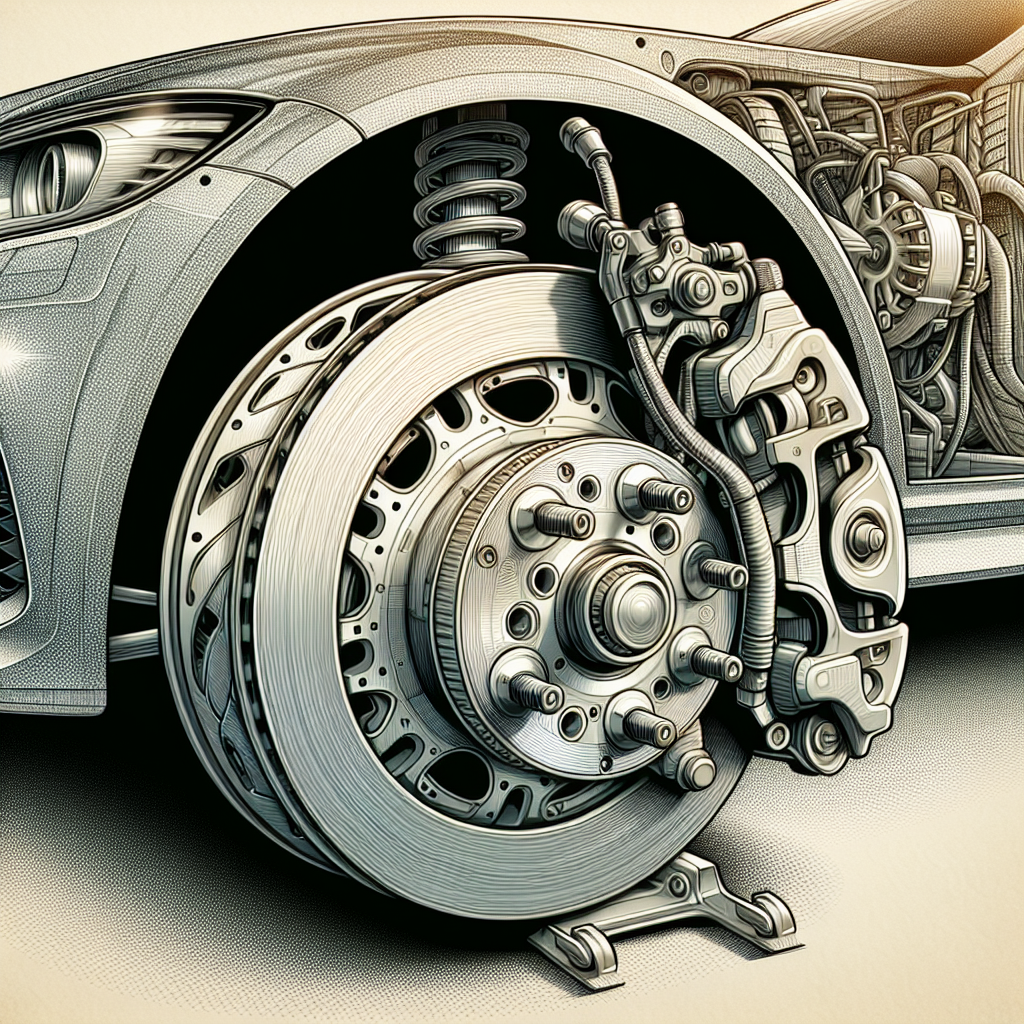Contents
Unlocking the Science Behind Safe Braking Techniques and Insights
In the dynamic world of motors and engines, where power and speed play a pivotal role, knowing how to halt your vehicle effectively is crucial for your safety. “Brake Down: The Science Behind Safe Braking” offers an in-depth analysis into the components, processes and maintenance techniques related to car braking systems.
As you navigate through this comprehensive article on xpertautocar.com, get ready to improve your understanding of the marvels of car braking, from brake pad materials to anti-lock braking systems, and even some emergency braking techniques for those crucial moments. Get ready to turn your simple commute into a fascinating journey of knowledge and safety.
| Key Insights at the Start of Your Journey into Safe Braking | |
|---|---|
| Brake Pad Materials | Semi-metallic, organic, ceramic – each with unique properties affecting stopping power |
| Brake Rotor Types | Vented, drilled, slotted, and smooth – each playing a role in the vehicle’s braking performance |
| Hydraulic Brake Systems | Essential components include the master cylinder, brake lines, calipers, pads, and rotors |
| ABS Functionality | Prevents wheel lock-up, enhancing safety in emergency braking |

Understanding Brake Pad Materials and Choices
Different Types of Brake Pad Materials and How They Affect the Science Behind Safe Braking
Your car’s stopping power is greatly influenced by the type of brake pad material it contains. When it comes to brake pad materials, there are predominantly three types: semi-metallic, organic, and ceramic. Semi-metallic pads are preferred due to their excellent heat dissipation and wear resistance characteristics. Organic brake pads, often made from various fibers mixed with high-temperature resins, provide quiet stops but tend to wear out faster. Ceramic pads reduce noise and dust, though they can be a bit pricey.
How to Choose the Right Brake Pads
Selecting a suitable brake pad depends on your car’s needs and your driving habits. If you frequently drive long-distance or at high speeds, semi-metallic or ceramic pads might be the best option. However, for city and light-journey drivers, organic pads may suffice. Always remember that the safety you get from high-quality brake pads is worth every dime you invest in them.
Quality vs. Price: A Balance
It may be enticing to save a few dollars on brake pads, but do keep in mind that cheaper is not always better. In the long run, buying quality brake pads can possibly save you unwanted repair bills and even serious accidents. It’s about striking a balance between quality and price while ensuring safety remains your top priority.
The Role of Brake Rotors in Performance
Understanding Brake Rotors
The brake rotor, also known as a brake disc, plays a fundamental role in your braking system. When you press the brake pedal, the brake pads clamp onto the rotors, creating friction that slows your vehicle. Brake rotors come in various types, including vented, drilled, slotted, and smooth, each serving a unique role.
How Brake Rotors Impact Performance
The brake rotor’s design and material can considerably affect your vehicle’s braking performance. For example, vented rotors, with their internal ventilation system, allow for efficient cooling, which improves brake performance in high-demand conditions. Drilled and slotted rotors, usually found in high-performance vehicles, provide better heat dissipation and prevent brake fade.
The Importance of Brake Rotor Maintenance
Regular maintenance of your brake rotors ensures longevity and maintains optimal brake system performance. Checking for signs of wear or damage, such as grooves or cracks, should be part of your routine checks. Getting your rotors machined or replaced when necessary helps guarantee a smooth and safe ride.
The Science Behind Safe Braking: Hydraulic Brake Systems Explained
The Function of Hydraulic Brake Systems
Hydraulic brake systems rely upon the physical principle of force multiplication to slow down your vehicle. When you step on the brake pedal, a plunger within the master cylinder is activated, pushing hydraulic fluid through the brake lines and applying force to the brake pads.
Components of a Hydraulic Brake System
An efficient hydraulic brake system includes the master cylinder, brake lines, brake calipers, brake pads, and brake rotors. The brake fluid, an often overlooked but crucial component, deserves special attention, as it must withstand high temperatures and pressure.
Maintenance Tips for Hydraulic Brakes
Maintain your hydraulic brake system by regularly checking and replacing your brake fluid as recommended by your vehicle manufacturer. Regular inspections for leaks in your brake lines and damage in other components like the master cylinder, pads, and rotors are key to a healthy hydraulic brake system.
The Importance of Regular Brake Inspections
Why Regular Brake Inspections are Crucial
Maximizing safety with regular brake inspections is a very important aspect of the science behind safe braking. Whether you’re in busy city traffic or on the open highway, your brakes are crucial for slowing down and stopping. Regular brake checks are key to identifying issues early, enhancing your safety, and avoiding expensive repairs.
What to Look Out for During a Brake Inspection
Brake inspections should check on several components. These include brake pads for any wastage, rotors for any wear and tear, brake fluid levels, and any potential leaks in brake lines. Warning signs such as squealing, grinding, or a spongy brake pedal should not be ignored.
Enhancing the Science Behind Safe Braking by Scheduling Regular Brake Inspections
As a general rule of thumb, most auto experts recommend having your brakes inspected every six months or with every other oil change. Of course, this will be influenced by your vehicle’s make, model, and your driving habits. So, it’s always beneficial to refer to your owner’s manual for more specific guidelines.
Brake Caliper Upgrades and Maintenance
What is a Brake Caliper?
The brake caliper is a crucial component of your vehicle’s brake system. It fits over the brake rotor like a clamp and houses the brake pads. Upon pressing the brake pedal, the brake caliper’s piston applies pressure to the brake pads, which come into contact with the spinning rotor to slow down your vehicle.
Benefits of Upgrading Your Brake Calipers
Upgrading your brake calipers can significantly enhance your vehicle’s braking performance. Bigger calipers allow for larger brake pads, providing more friction surface area and better heat dissipation. Moreover, some higher-performance brake calipers come with multiple pistons for stronger clamping force.
How to Maintain Your Brake Calipers
Routine checks for leaks, visible damage and proper moving of the caliper’s piston are crucial to maintaining your brake calipers. If you live in an area prone to rust or corrosion, applying appropriate protective coatings can extend the life of your brake calipers.
Disc vs. Drum Brakes: Pros and Cons
Understanding Disc Brakes
Disc brakes consist of a rotor and brake calipers that house the brake pads. When the brake pedal is pressed, the calipers squeeze the brake pads onto the rotor, creating the friction required to slow or stop the vehicle. They offer excellent stopping power, perform well in wet conditions, and are easier to inspect and maintain, making them the more popular option among modern car manufacturers.
Understanding Drum Brakes
In a drum brake system, the brake shoes push out against a spinning drum attached to the wheel, producing friction. While typically cheaper to produce than disc brakes, drum brakes are less efficient at heat dissipation and could suffer from brake fade during prolonged use. However, on low-demand applications like rear wheels or smaller cars, they can still be valid options.
Assessing the Pros and Cons of Both
Comparing disc and drum brakes in the context of the science behind safe braking, disc brakes are often preferred for their superior performance, easier maintenance, and better heat dissipation. However, drum brakes, known for their cost-efficiency, can provide adequate stopping power, especially for smaller cars or the rear wheels. Each type has its pros and cons, and the right choice depends on the specific requirements of your vehicle and your personal preferences.
Brake Fluid Types and Maintenance
Different Types of Brake Fluid
There are three main types of brake fluid: DOT3, DOT4, and DOT5. DOT3 and DOT4 are glycol-based and can absorb water making them prone to boiling under intense heat. DOT5 fluid is silicone-based, doesn’t absorb water, and resists heat better, although it’s more expensive.
The Importance of Regular Brake Fluid Checks
Regularly checking your brake fluid level is critical in maintaining your vehicle’s braking performance. Low brake fluid can introduce air into the system, leading to a spongy brake pedal and decreased stopping power.
Maintaining Your Vehicle’s Brake Fluid
Scheduling regular brake fluid changes is a key aspect of the science behind safe braking. Follow your vehicle manufacturer’s recommendation, usually every two years. Change the fluid immediately if it’s discolored or contaminated. Ensuring the reservoir is properly sealed is crucial to prevent moisture absorption and contamination.
Anti-Lock Braking System (ABS) Functionality
Understanding the Function of ABS
The Anti-Lock Braking System (ABS) is a safety feature designed to prevent your wheels from locking up or skidding during sudden braking. It does this by rapidly modulating the brake pressure to each wheel, allowing you to maintain steering control even while braking intensely.
How ABS Enhances Safety
ABS provides significant safety benefits, especially in slippery conditions. By preventing wheel lock-up, ABS lets you steer the vehicle around an unexpected obstacle while simultaneously braking. ABS can greatly improve your vehicle’s stopping distance on slippery surfaces and give you a more controlled emergency stop.
Caring for Your Vehicle’s ABS
To keep your ABS running optimally, regular inspections and occasional professional service are crucial. Any warning lights on your dashboard indicating ABS malfunctions should be addressed promptly. Ensure your tires are properly inflated and have good tread depth, as ABS relies on the tire’s traction.

Emergency Braking Techniques and Systems
Different Emergency Braking Techniques
In emergency scenarios, such as a sudden obstacle or an unexpected pedestrian, understanding the science behind safe braking is vital for performing an emergency stop effectively. The technique varies based on your vehicle’s braking system. With ABS, apply consistent, firm pressure on the brake pedal. In vehicles without ABS, practice threshold braking – applying enough force to stop quickly without locking the wheels.
Modern Emergency Braking Systems
Many modern vehicles are now equipped with automatic emergency braking systems. These use sensors to detect potential collisions and apply the brakes if the driver doesn’t react in time. Remember, these systems are designed to assist you, not replace mindful and responsible driving.
Practicing Safe Emergency Braking
It’s beneficial to familiarize yourself with emergency braking techniques under controlled conditions. Comprehensive driver’s education courses often incorporate such practices. Always maintain a safe driving distance and ensure your vehicle’s brakes are in top shape for real-world emergencies.
Brake Light System and Safety
Understanding the Brake Light System
Your brake light system, while simple, plays a critical role in vehicular safety and is an often overlooked aspect in the science behind safe braking. Whenever you tap on the brake pedal, the brake lights illuminate, signaling to drivers behind you that you’re slowing down or stopping.
The Role of Brake Lights in Safety
Brake lights provide crucial information to other road users, helping to prevent rear-end collisions. Having functional brake lights is not only a legal requirement but also an essential element of road safety.
Troubleshooting Brake Light Issues
If you’re alerted by another driver or notice in reflections that your brake lights aren’t functioning, you must address this immediately. Bulb replacement, checking the brake light switch, and inspecting the fuse box are common troubleshooting steps. For persistent issues, it’s best to consult with a professional mechanic.
Brake maintenance should never be overlooked. Whether you’re a daily commuter or an occasional driver, regular inspections and preemptive care can provide better performance, increase component lifespan, and most importantly, ensure your safety on the road. We hope you’ve wenjoy getting to know a bit more about the science behind safe braking and if you ever need service we are just a phone call away (678-698-0604).

| Final Takeaways on Mastering Safe Braking Techniques | |
|---|---|
| Regular Brake Inspections | Key to early identification of issues, enhancing safety and avoiding costly repairs |
| Brake Caliper Maintenance | Checks for leaks and damage, upgrading for enhanced performance |
| Disc vs. Drum Brakes | Assessing pros and cons for optimal braking performance |
| Brake Fluid Management | Regular checks and changes as per vehicle specifications for optimal performance |
| Emergency Braking Techniques | Understanding and practicing safe braking in emergency situations |
| Brake Light System | Ensuring functionality for safety and communication with other road users |
Thanks for stopping by..! 🙂





